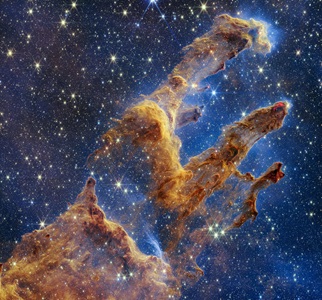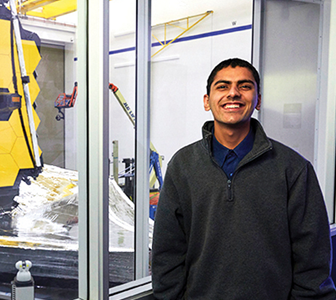The James Webb Space Telescope is Changing Our Understanding of the Universe — Here are 3 of its Top Observations So Far
A New Era in Astronomy

By Jonathan Beyoghlow
This July, Northrop Grumman celebrates the one-year anniversary of scientific operations by NASA’s James Webb Space Telescope (Webb). Northrop Grumman built Webb in partnership with NASA and played an integral role in enabling a successful first year. This remarkable milestone has provided a new window to the cosmos; the telescope has observed incredible cosmic structures, explored uncharted areas of the universe and allowed astronomers and the public to behold the stunning beauty and complexity of space. Webb is a testament to human ingenuity and represents a new chapter in our exploration of the unknown.
Today, our Northrop Grumman team supports the operations and maintenance of Webb , allowing the observatory to perform optimally in space and capture stunning images. Webb is performing beyond expectations and is at the very beginning of its long operational life.
“Webb’s breakthrough technology and advanced engineering is powering a new era for humankind to explore the earliest stars and galaxies,” said Dr. Candace Givens, Northrop Grumman’s vice president, Overhead Persistent Infrared and Geospatial Systems business unit. “The potential for us to answer some of the most significant questions about the cosmos and how the universe formed is very much a possibility now.”
Here are some highlights from Webb’s first year of scientific operations:

#1: Capturing What's Out There
Webb has already observed the deepest and sharpest infrared image of the distant universe, advanced our understanding of exoplanets and assisted astronomers to study the complexity of early star formation in much more detail.
Thanks to Webb’s powerful instruments, the observatory has already provided astronomers unprecedented views of the universe, revealing more about space than scientists had originally anticipated. For instance, in late June 2023, Webb detected a new carbon compound in the galaxy for the first time. The discovery of complex carbon molecules can offer pivotal clues about the formation and evolution of life, not just on Earth but potentially elsewhere in the universe.
Since sharing its first images of the cosmos in July 2022, NASA and the Space Telescope Science Institute have shared approximately 60 stunning images. This included one that successfully confirmed the existence of a protocluster comprising seven galaxies, corresponding to a time only 650 million years after the Big Bang, as well as one that showed the impact of NASA’s DART spacecraft colliding into a small asteroid. These images have enhanced humankind’s understanding of the universe and begun to reshape the limits of our perspective. Furthermore, they have helped scientists not only estimate the number of galaxies in the universe, but also understand how they evolve.
Photo: Fomalhaut Dusty Debris Disk
Photo Credit: NASA, ESA, CSA, András Gáspár (University of Arizona), Alyssa Pagan (STScI)

#2: Continuing the Scientific Mission
Every 168 days, Webb completes one circuit around Lagrange Point 2 (L2), which is over 3 million miles. L2 is a gravitationally stable region in space, optimizing Webb’s use of fuel and extending its operational lifetime. Protected from harsh thermal environments of the Earth, Moon and Sun, Webb is in an ideal location for making observations deep into the universe.
Its on-board communication system, designed by our team at Northrop Grumman, allows the operations team on Earth to send and receive signals to the observatory. This allows scientists and engineers to monitor trends related to Webb’s innerworkings (such as tank pressures and temperatures) and ensure the observatory is performing as expected.
Photo: Wolf-Rayet Star in the Sagittarius constellation
Photo Credit: NASA, ESA, CSA, STScI, Webb ERO Production Team

#3: Discovering What’s Next
In collaboration with the Space Telescope Science Institute (STScI), Webb is being used as part of critical research to better understand the universe. Its next research cycle kicked off at the beginning of this month, on July 1, 2023, and astronomers around the world are gearing up for another exciting year of discoveries. The 249 research proposals selected for this cycle will focus on helping to unlock the universe’s deepest mysteries. One researcher will use Webb to observe galaxies that formed just 200 million years after the big bang. Another seeks to investigate Saturn’s moon, Enceladus, which may further support evidence of an ocean beneath its surface. The science data produced by Webb in its second year will have a profound impact on astronomy, helping astronomers better understand the vast size of the universe and the distribution of galaxies and their evolution over time.
As astronomers and the public continue to observe stunning views of distant galaxies, stars and planets, Webb has reminded us that Earth is part of something much more complex and beautiful.
Photo: New Image of Uranus
Photo Credit: Photo Credit: NASA, ESA, CSA, STScI, with image processing by Joseph DePasquale (STSci)
Learn more about our work on Webb, or explore what it’s like to work at Northrop Grumman.
Header Image at top of page: The first anniversary image from NASA’s James Webb Space Telescope is the Rho Ophiuchi cloud complex, the closest star-forming region to Earth. (Photo Credit: NASA)


